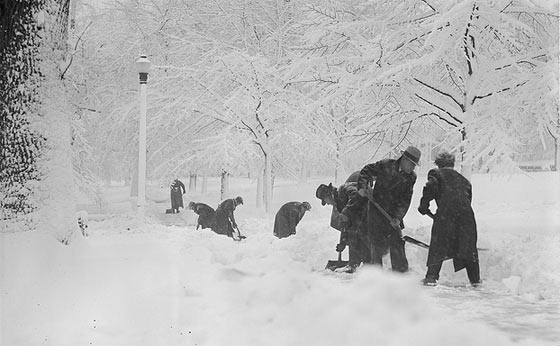How NOT to get a Heart Attack while Shoveling Snow

It’s true. Shoveling snow can trigger a heart attack.
Are there things you can do to lower the risk of heart attack while shoveling snow? Yes, there are. Especially for the middle aged and older, take these precautions…
What Causes a Heart Attack while Shoveling Snow
1. It can be the SUDDEN burst of heavy physical exertion.
2. Sudden increase in heart rate and blood pressure.
3. Cold air constriction of blood vessels, reducing oxygen to heart.
All of this puts strain on the cardiovascular system and may lead to heart attack.
Statistical data from ClevelandClinic.org indicates approximately 800 people are hospitalized each year with cardiac problems from shoveling snow. Many of them are heart attacks.
A report from harvard.health.edu revealed a study whereby “snowfalls of more than eight inches, there was a 16% increase in hospital admissions compared to days with no snow.”
“The deeper the snow, the more men died of heart attacks. A 34% increase was observed the day after an eight-inch snowfall, and higher rates were noted when even more snow fell.”
How To Lower Your Heart Attack Risk Shoveling Snow
1. DON’T SHOVEL SNOW.
If you’re particularly at risk, why risk it? Maybe someone else can do it. Maybe you can pay to have it done. If those aren’t options for you, then read on:
2. Reduce SUDDEN exertion. WARM UP FIRST. Start shoveling slow and easy. Don’t go fast. Slower is fine. Start slowly, but also stop slowly. Continue moving and stretching for a few minutes before sitting down.
3. Take breaks! Don’t over stress your heart. You don’t need to get it all done without a break, right?
4. Use a smaller shovel or take smaller shovel-fulls. This is especially important with heavy wet snow.
5. Listen to your body. Be aware of your level of exertion and heart rate. If you know that you are over exerting yourself, slow down.
NOTE: Even using a snow blower or snow thrower may stress the system beyond what’s ‘safe’.
It all sounds like common sense. But the thing is, many people start their shoveling snow FULL-ON. You might want to think twice about that.
Even though most people living in the snow belts have a snow blower, there’s shoveling to be done nonetheless – so be careful, take it easy, and survive!
Signs of a Heart Attack
According to the American Heart Association,
Heart attacks may start slowly. Just mild pain or discomfort. People affected might not be sure what’s wrong at first.
CHEST DISCOMFORT
“Most heart attacks involve discomfort in the center of the chest that lasts more than a few minutes, or that goes away and comes back. It can feel like uncomfortable pressure, squeezing, fullness or pain.”
DISCOMFORT IN OTHER AREAS
“Discomfort in other areas of the upper body. Symptoms can include pain or discomfort in one or both arms, the back, neck, jaw or stomach.”
SHORTNESS OF BREATH
“Shortness of breath with or without chest discomfort.”
COLD SWEAT
Other signs may include breaking out in a cold sweat, nausea or lightheadedness.
MEN vs. WOMEN
“As with men, women’s most common heart attack symptom is chest pain or discomfort. But women are somewhat more likely than men to experience some of the other common symptoms, particularly shortness of breath, nausea/vomiting, and back or jaw pain.”
TIP: Don’t slip and fall. Use ice cleats on your boots. Here’s an article that I wrote about it (my best ice cleats).
In addition to my big snow blower, I have used the following electric ‘power shovel’ for a number of years. I use it for blowing snow off the porch deck. Convenient.
We just got dumped on with snow again yesterday (my inspiration for this post). To make matters worse, it has been below zero all night and all day. Not fun! At least this new snow is light and fluffy (and deep!).
